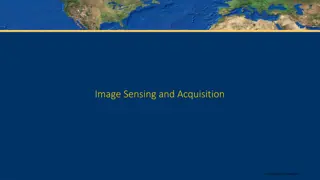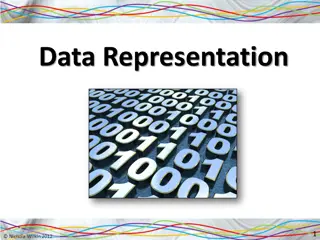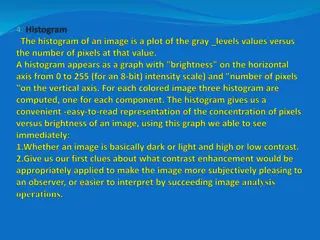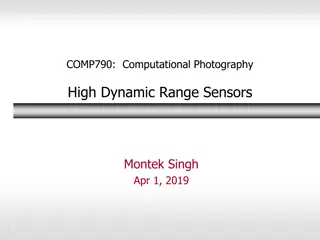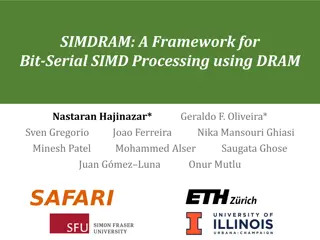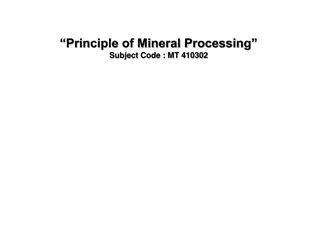Understanding Pixel Relationships in Image Processing
Exploring the fundamental concepts of pixel relationships in image processing, including 4-neighbors, 8-neighbors, adjacency criteria, and their significance in digital image analysis. The content covers the basics of pixel connectivity and neighbor sets, offering insights into how pixels interact and influence image processing algorithms.
Download Presentation

Please find below an Image/Link to download the presentation.
The content on the website is provided AS IS for your information and personal use only. It may not be sold, licensed, or shared on other websites without obtaining consent from the author. Download presentation by click this link. If you encounter any issues during the download, it is possible that the publisher has removed the file from their server.
E N D
Presentation Transcript
Prepared by K.Indragandhi,AP(Sr.Gr.)/ECE
f(0,0) f(0,1) f(0,2) f(0,3) f(0,4) - - - - - f(1,0) f(1,1) f(1,2) f(1,3) f(1,4) - - - - - f(x,y) = f(2,0) f(2,1) f(2,2) f(2,3) f(2,4) - - - - - f(3,0) f(3,1) f(3,2) f(3,3) f(3,4) - - - - - I I I I I - - - - - I I I I I - - - - -
f(0,0) f(0,1) f(0,2) f(0,3) f(0,4) - - - - - f(1,0) f(1,1) f(1,2) f(1,3) f(1,4) - - - - - f(x,y) = f(2,0) f(2,1) f(2,2) f(2,3) f(2,4) - - - - - f(3,0) f(3,1) f(3,2) f(3,3) f(3,4) - - - - - I I I I I - - - - - I I I I I - - - - - A Pixel p at coordinates ( x, y) has 4 horizontal and vertical neighbors. Their coordinates are given by: (x+1, y) (x-1, y) (x, y+1) & (x, y-1) f(2,1) f(0,1) f(1,2) f(1,0) This set of pixels is called the 4-neighborsof p denoted by N4(p). Each pixel is unit distance from ( x ,y).
f(0,0) f(0,1) f(0,2) f(0,3) f(0,4) - - - - - f(1,0) f(1,1) f(1,2) f(1,3) f(1,4) - - - - - f(x,y) = f(2,0) f(2,1) f(2,2) f(2,3) f(2,4) - - - - - f(3,0) f(3,1) f(3,2) f(3,3) f(3,4) - - - - - I I I I I - - - - - I I I I I - - - - - A Pixel p at coordinates ( x, y) has 4 diagonal neighbors. Their coordinates are given by: (x+1, y+1) (x+1, y-1) (x-1, y+1) & (x-1, y-1) f(2,2) f(2,0) f(0,2) f(0,0) This set of pixels is called the diagonal-neighborsof p denoted by ND(p). diagonal neighbors + 4-neighbors = 8-neighbors of p.
Adjacency: Two pixels are adjacent if they are neighbors and their intensity level V satisfy some specific criteria of similarity. e.g. V = {1} V = { 0, 2} Binary image = { 0, 1} Gray scale image = { 0, 1, 2, ------, 255} In binary images, 2 pixels are adjacent if they are neighbors & have some intensity values either 0 or 1. In gray scale, image contains more gray level values in range 0 to 255.
4-adjacency:Two pixels p and q with the values from set V are 4-adjacent if q is in the set of N4(p). e.g. V = { 0, 1} 1 1 2 1 1 0 1 0 1 p in RED color q can be any value in GREEN color.
8-adjacency:Two pixels p and q with the values from set V are 8-adjacent if q is in the set of N8(p). e.g. V = { 1, 2} 0 1 1 0 2 0 0 0 1 p in RED color q can be any value in GREEN color
m-adjacency:Two pixels p and q with the values from set V are m-adjacent if (i) q is in N4(p) OR (ii) q is in ND(p) & the set N4(p) n N4(q) have no pixels whose values are from V . e.g. V = { 1 } 0 a 1 b 1 c 0 d 1 e 0 f 0 g 0 h 1 i
m-adjacency:Two pixels p and q with the values from set V are m-adjacent if (i) q is in N4(p) e.g. V = { 1 } (i) b & c 0 a 1 b 1 c 0 d 1 e 0 f 0 g 0 h 1 I
m-adjacency:Two pixels p and q with the values from set V are m-adjacent if (i) q is in N4(p) e.g. V = { 1 } (i) b & c 0 a 1 b 1 c 0 d 1 e 0 f 0 g 0 h 1 I Soln: b & c are m-adjacent.
m-adjacency:Two pixels p and q with the values from set V are m-adjacent if (i) q is in N4(p) e.g. V = { 1 } (ii) b & e 0 a 1 b 1 c 0 d 1 e 0 f 0 g 0 h 1 I
m-adjacency:Two pixels p and q with the values from set V are m-adjacent if (i) q is in N4(p) e.g. V = { 1 } (ii) b & e 0 a 1 b 1 c 0 d 1 e 0 f 0 g 0 h 1 I Soln: b & e are m-adjacent.
m-adjacency:Two pixels p and q with the values from set V are m-adjacent if (i) q is in N4(p) OR e.g. V = { 1 } (iii) e & i 0 a 1 b 1 c 0 d 1 e 0 f 0 g 0 h 1 i
m-adjacency:Two pixels p and q with the values from set V are m-adjacent if q is in ND(p) & the set N4(p) n N4(q) have no pixels whose values are from V . e.g. V = { 1 } (iii) e & i 0 a 1 b 1 c 0 d 1 e 0 f 0 g 0 h 1 I (i)
m-adjacency:Two pixels p and q with the values from set V are m-adjacent if q is in ND(p) & the set N4(p) n N4(q) have no pixels whose values are from V . e.g. V = { 1 } (iii) e & i 0 a 1 b 1 c 0 d 1 e 0 f 0 g 0 h 1 I (i) Soln: e & i are m-adjacent.
m-adjacency:Two pixels p and q with the values from set V are m-adjacent if (i) q is in N4(p) OR (ii) q is in ND(p) & the set N4(p) n N4(q) have no pixels whose values are from V . e.g. V = { 1 } (iv) e & c 0 a 1 b 1 c 0 d 1 e 0 f 0 g 0 h 1 I
m-adjacency:Two pixels p and q with the values from set V are m-adjacent if (i) q is in N4(p) OR (ii) q is in ND(p) & the set N4(p) n N4(q) have no pixels whose values are from V . e.g. V = { 1 } (iv) e & c 0 a 1 b 1 c 0 d 1 e 0 f 0 g 0 h 1 I Soln: e & c are NOT m-adjacent.
Connectivity: 2 pixels are said to be connected if their exists a path between them. Let S represent subset of pixels in an image. Two pixels p & q are said to be connected in S if their exists a path between them consisting entirely of pixels in S . For any pixel p in S, the set of pixels that are connected to it in S is called a connected component of S.
Paths: A path from pixel p with coordinate ( x, y) with pixel q with coordinate ( s, t) is a sequence of distinct sequence with coordinates (x0, y0), (x1, y1), .., (xn, yn) where (x, y) = (x0, y0) & (s, t) = (xn, yn) Closed path: (x0, y0) = (xn, yn)
Example # 1: Consider the image segment shown in figure. Compute length of the shortest-4, shortest-8 & shortest-m paths between pixels p & q where, V = {1, 2}. 4 2 3 2 q 3 3 1 3 2 3 2 2 p 2 1 2 3
Example # 1: Shortest-4 path: V = {1, 2}. 4 2 3 2 q 3 3 1 3 2 3 2 2 p 2 1 2 3
Example # 1: Shortest-4 path: V = {1, 2}. 4 2 3 2 q 3 3 1 3 2 3 2 2 p 2 1 2 3
Example # 1: Shortest-4 path: V = {1, 2}. 4 2 3 2 q 3 3 1 3 2 3 2 2 p 2 1 2 3
Example # 1: Shortest-4 path: V = {1, 2}. 4 2 3 2 q 3 3 1 3 2 3 2 2 p 2 1 2 3
Example # 1: Shortest-4 path: V = {1, 2}. 4 2 3 2 q 3 3 1 3 2 3 2 2 p 2 1 2 3
Example # 1: Shortest-4 path: V = {1, 2}. 4 2 3 2 q 3 3 1 3 2 3 2 2 p 2 1 2 3 So, Path does not exist.
Example # 1: Shortest-8 path: V = {1, 2}. 4 2 3 2 q 3 3 1 3 2 3 2 2 p 2 1 2 3
Example # 1: Shortest-8 path: V = {1, 2}. 4 2 3 2 q 3 3 1 3 2 3 2 2 p 2 1 2 3
Example # 1: Shortest-8 path: V = {1, 2}. 4 2 3 2 q 3 3 1 3 2 3 2 2 p 2 1 2 3
Example # 1: Shortest-8 path: V = {1, 2}. 4 2 3 2 q 3 3 1 3 2 3 2 2 p 2 1 2 3
Example # 1: Shortest-8 path: V = {1, 2}. 4 2 3 2 q 3 3 1 3 2 3 2 2 p 2 1 2 3
Example # 1: Shortest-8 path: V = {1, 2}. 4 2 3 2 q 3 3 1 3 2 3 2 2 p 2 1 2 3 So, shortest-8 path = 4
Example # 1: Shortest-m path: V = {1, 2}. 4 2 3 2 q 3 3 1 3 2 3 2 2 p 2 1 2 3
Example # 1: Shortest-m path: V = {1, 2}. 4 2 3 2 q 3 3 1 3 2 3 2 2 p 2 1 2 3
Example # 1: Shortest-m path: V = {1, 2}. 4 2 3 2 q 3 3 1 3 2 3 2 2 p 2 1 2 3
Example # 1: Shortest-m path: V = {1, 2}. 4 2 3 2 q 3 3 1 3 2 3 2 2 p 2 1 2 3
Example # 1: Shortest-m path: V = {1, 2}. 4 2 3 2 q 3 3 1 3 2 3 2 2 p 2 1 2 3
Example # 1: Shortest-m path: V = {1, 2}. 4 2 3 2 q 3 3 1 3 2 3 2 2 p 2 1 2 3
Example # 1: Shortest-m path: V = {1, 2}. 4 2 3 2 q 3 3 1 3 2 3 2 2 p 2 1 2 3 So, shortest-m path = 5
Region: Let R be a subset of pixels in an image. Two regions Ri and Rj are said to be adjacent if their union form a connected set. Regions that are not adjacent are said to be disjoint. We consider 4- and 8- adjacency when referring to regions. Below regions are adjacent only if 8-adjacency is used. 1 1 1 1 0 1 Ri 0 1 0 0 0 1 1 1 1 Rj 1 1 1
Boundaries (border or contour): The boundary of a region R is the set of points that are adjacent to points in the compliment of R. 0 0 0 0 0 0 1 1 0 0 0 1 1 0 0 0 1 1 1 0 0 1 1 1 0 0 0 0 0 0 RED colored 1 is NOT a member of border if 4-connectivity is used between region and background. It is if 8-connectivity is used.




